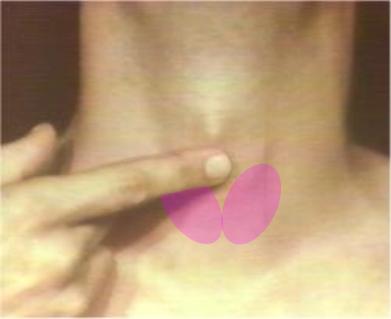Hospital Corpsman Sickcall Screener's Handbook
BUMEDINST 6550:9A
Naval Hospital Great Lakes
1999
Endocrine System
The endocrine system functions to maintain homeostasis of the body’s internal environment. It maintains a fine balance between too much or too little-too much glucose or not enough thyroid hormone. The endocrine system secretes chemical substances called hormones directly into the bloodstream. The concentration is maintained at an appropriate level in the bloodstream by a "feedback" control mechanism. If the hormone concentration increases, further production of the hormone is inhibited. When the concentration decreases, production of the hormone is then stimulated. Hormones are the main regulators of metabolism, growth and development, reproduction and stress response. All endocrine disorders are caused by either excess or deficiency of the hormones.
ANATOMY AND PHYSIOLOGY OF THE THYROID
The thyroid is located in the neck and has an "H" shaped appearance. The hormones formed are T3 and T4. Iodine is necessary for the formation of T3 and T4. If iodine is lacking in the diet, the thyroid fails to make the hormone and gets very large, increasing tissue in an effort to compensate-resulting in a goiter.The hypothalamus secretes TRH-Thyroid Releasing hormone which stimulates the pituitary to secrete TSH-Thyroid Stimulating Hormone which stimulates the thyroid to produce T3 and T4. The blood level of T3 and T4 functions as the feedback control mechanism for pituitary and hypothalamus.
-
Normally when T3 and T4 levels fall, TRH and TSH levels should be increased to stimulate the thyroid.
-
Normally when T3 and T4 levels rise, TRH and TSH levels should be decreased to inhibit the thyroid.
|
 |
|
Military
Medical CDs
Textbooks, Manuals, Instructions,
Videos
On-line Resources
www.brooksidepress.org |
EXAMINING THE THYROID
Look at the patients neck from the front. Note the presence of old surgical scars, distended veins, or redness. Watch the movement of the thyroid gland the patient swallows. Examine the head and neck distal to the thyroid; observe the position of the trachea. Then examine the thyroid: one widely recommended method is to palpate the patients neck with the fingertips of both hands while standing behind the seated patient. Locate the cricoid cartilage, a very important step when the thyroid gland is normal or subnormal in size. When your index fingers rest just under the lower rim of the cricoid, the lower portion of those fingers is over the top of the thyroid. Rotate your second and third fingers over the rest of the gland, evaluating its size, contour, consistency, and freedom of movement.
HYPOTHYROIDISM: Results from inadequate production of the thyroid hormone, causing a hypometabolic state. If very severe it is also called Myxedema.
S: Weakness, fatigue, cold intolerance, constipation, and weight gain.
O: Dry hair and skin, brittle nails, diminished muscle strength and reflexes. May have a puffy face and eyelids, thick tongue and bradycardia.
A: Hypothyroidism/Myxedema
P: Refer to the MD/PA
Treatment is to replace the T4 with oral thyroid medication.
HYPERTHYROIDISM: Is the result of excessive production of thyroid hormone. The most common cause is Graves disease. This is an autoimmune disorder. Abnormal antibodies are made that stimulate the thyroid by binding at the same site as the
TSH. With the increased T3 and
T4 production, TSH
stimulation is stopped by the feedback mechanism, but the hormone production continues. This is due to the antibodies taking over the function of stimulating the thyroid and all control is lost. Hyperthyroidism may also be caused by a tumor in the thyroid or by a tumor in the pituitary that secrete excessive
TSH.
S: Weakness, sweating, weight loss, increased appetite, fatigue, nervousness, diarrhea, and heat intolerance.
O: Tachycardia, warm this moist skin, tumors, hyperactive reflexes, exophthalmos (Bug Eyes), palpable thyroid or goiter. If long standing, wasting of muscle may occur.
A: Hyperthyroidism
P: Refer to the MD/PA
NOTE: Exophthalmos is caused by disposition of fat in back of the globe causing forward protrusion.
ANATOMY AND PHYSIOLOGY OF THE PANCREAS
The pancreas is located behind the stomach horizontally. It’s head is attached to the duodenum and its tail reaches to the spleen. Scattered throughout the spleen are groups of cells referred to as the islets of Langerhans that secrete insulin. Insulin lowers the blood glucose by assisting the movement of glucose into the cells. The blood glucose level rises because glucose cannot enter the cells where it is used for energy. Without insulin the serum glucose level rises because the glucose cannot enter the cells, it then spills over into the urine. How much insulin is released into the body is normally determined by the level of sugar in the blood which works as a feedback system.
Diabetes Mellitus: A disorder of carbohydrates (glucose) metabolism, characterized by hyperglycemia (elevated level of
glucose in the blood) and glycosuria (glucose in the
urine). This is the result of inadequate production or utilization of insulin. There are two types.
Type I Diabetes-occurs abruptly with an absence of insulin due to a decline in the insulin producing cell (autoimmune destruction?). Because of the periodic administration of insulin it is called insulin dependent diabetes.
Type II Diabetes: most common type (90%), affects people who are over 40 years of age, and overweight. It is usually controlled by a diet, exercise, and oral antidiabetic drugs.
S: Three classic symptoms- polyuria, polydipsia, and polyphagia, or urinates, drinks, and eats very often. Weight loss, fatigue, recurrent infections, pruritis, or may be asymptomatic.
O: Variable physical findings, only reliable findings is an elevated blood glucose on a fasting specimen.
U/A may have glucose.
|
|
Approved for public release;
Distribution is unlimited.
The listing of any non-Federal product in this CD is not an endorsement of the
product itself, but simply an acknowledgement of the source.
Bureau of Medicine and Surgery
Department of the Navy
2300 E Street NW
Washington, D.C
20372-5300 |
Operational Medicine
Health Care in Military Settings
CAPT Michael John Hughey, MC, USNR
NAVMED P-5139
January 1, 2001 |
United States Special Operations
Command
7701 Tampa Point Blvd.
MacDill AFB, Florida
33621-5323 |
*This web version is provided by
The Brookside Associates Medical Education Division. It contains
original contents from the official US Navy NAVMED P-5139, but has been
reformatted for web access and includes advertising and links that were not
present in the original version. This web version has not been approved by the
Department of the Navy or the Department of Defense. The presence of any
advertising on these pages does not constitute an endorsement of that product or
service by either the US Department of Defense or the Brookside Associates. The
Brookside Associates is a private organization, not affiliated with the United
States Department of Defense.
Contact Us · · Other
Brookside Products

|
|
Operational Medicine 2001
Contents
|
|
 |
|
FMST Student Manual Multimedia CD
30 Operational Medicine Textbooks/Manuals
30 Operational Medicine Videos
"Just in Time" Initial and Refresher Training
Durable Field-Deployable Storage Case |
|




